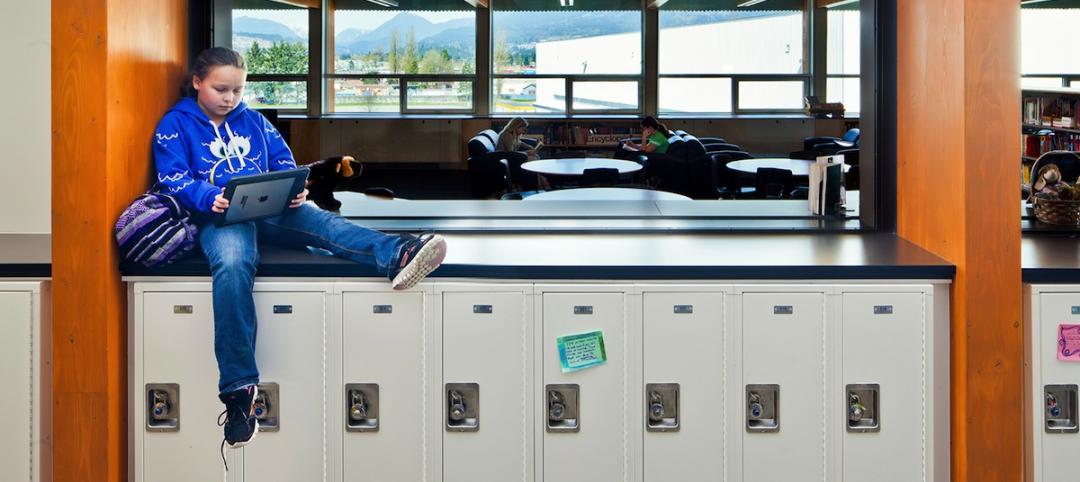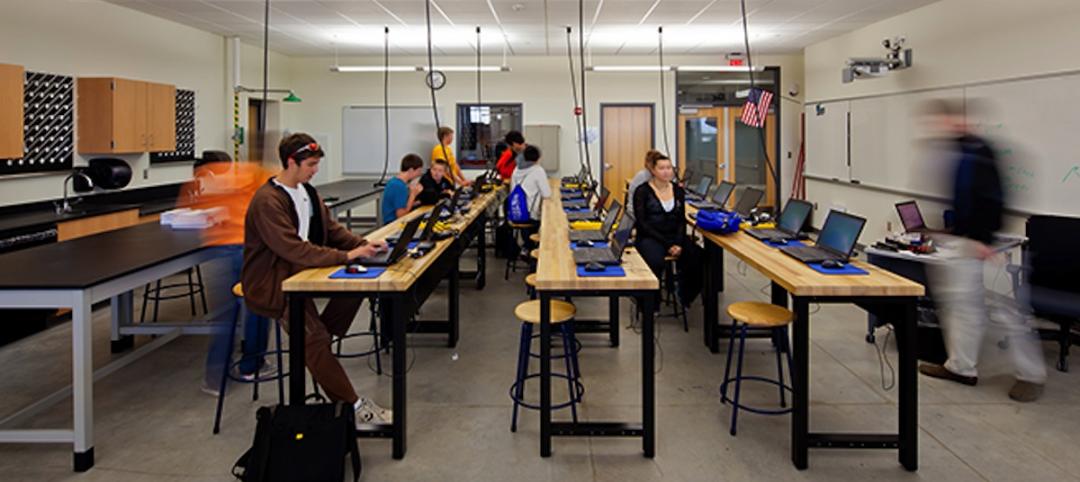Last Tuesday, the Northeast Community Propel Academy, a K-8 school with the capacity for 1,660 students, opened In Philadelphia. The 180,000-sf building was financed and constructed through a public-private partnership between the School District of Philadelphia and Gilbane Development Company, which provided turnkey development for the new school.
Gilbane Building Company acted as the project’s design-builder and hired Stantec as its architect. Gilbane was one of three firms that submitted bid proposals to the school district in the fall of 2017, and received the contract the following January, says Susan Tully, Senior Project Manager and Market Leader for Gilbane’s K-12 Center of Excellence. The school’s design was completed by October 2019, and after some municipal delays construction began in March 2020, “on the day the world stopped” because of the coronavirus pandemic, quipped Tully.
Propel Academy is in a multicultural section of Philadelphia that “is booming,” says Tully, with lots of service sector workers. But the number of school seats hadn’t kept pace with the community’s growth; Tully notes that another school there, built for 600 students, now serves 2,000. The district “knew they need to get a new school built quickly,” she recalls.
The school is on land that previously had served as baseball and softball fields. As part of the P3 agreement, Gilbane Development purchased the land from the school district for $1, and upon completion of construction on August 19, 2021 sold the property and school back to the school district for $79 million.
“Speed to market was a driver” for the P3 arrangement, says Luis Vildostegui, Stantec’s Senior Principal and Education Leader, whom BD+C interviewed with Jennifer Grafton, Stantec’s Project Manager and Senior Associate. Vildostegui notes that Propel Academy’s design reflects the school district’s gravitation toward a more socialized teaching model that focuses on learning with peers.
SCHOOL FEATURES COLLABORATIVE ZONES
Gilbane and Stantec, with Fengate Asset Management, were part of a construction financing consortium that in June broke ground on six K-12 schools in Prince George’s County, Md. This was the first P3 for schools in the nation, and it’s expected to cut in half the time it takes to complete those schools, which are scheduled to open in 2023.
In Philadelphia, the Propel Academy project “is one of the most collaborative I’ve worked on in my career,” says Tully. One of its advantages was Gilbane’s relationship with Stantec, which provided architecture, interior design, and civil engineering services. “We were able to advance the construction before the designs were completed, which fast-tracked the project,” says Grafton. And because Stantec had worked previously with the school district and Gilbane, “we could act as an intermediary” when decisions were made, says Vildostegui.
Stantec’s office in Philadelphia is right across the street from the school district’s, so it set up a big room where all of the project’s stakeholders could meet conveniently. “We were all there, resolving problems from the beginning,” says Vildostegui. Any additions or changes during the design or construction process had to be “cost-neutral solutions,” says Tully. (Nicole Ward, AIA, the school district’s design manager, was its liaison on this project.)
Those discussions included “challenging some basic assumptions,” says Vildostegui, like the building’s placement, which is adjacent to a park that exposures city kids to natural environments they might not see otherwise. During the permitting stage, the building team and school district also hashed out whether a retention basin on the site should be above or below ground (they ultimately chose the latter).
The building team’s early collaboration allowed its members to react quicker when there were materials shortages or delays. “We didn’t need to make compromises,” says Tully.

The Propel Academy was build on land that once served as ball fields, and is located near a tree-lined park.
A ‘SHINING SUCCESS STORY’ FOR P3s
Propel Academy is organized into clusters of classrooms and collaborative zones for small learning groups. There are six classrooms per grade for grades 1-5, and nine classrooms per grade for grades 6-8. The classrooms are positioned around shared media and tech commons within each grade level house, and the number of classrooms can be adjusted as needed.
The school also has science labs, music rooms, and “exploration” spaces, says Grafton. “It’s transformative,” says Vildostegui about the school’s design, that had to meet what Tully calls the school district’s “strict design standards” that are informed by LEED and WELL guidelines.
Tully sees Propel Academy as a “test case” for the school district, and believes P3 financial agreements will be more in vogue for financing school construction to meet clients’ demands for speed. “It’s a shining success story” for the P3 approach, adds Vildostegui. “It’s not for every project, but it’s quicker than a traditional design-bid-build because the issues get moved upfront.”
Related Stories
K-12 Schools | May 12, 2015
Bjarke Ingels completes Danish high school sports and arts expansion
By placing parts of the new building beneath the football fields, the students are able to walk through the sunken sports hall at the center of the school´s courtyard to the classrooms, cafeteria, and out to the main entrance at street level.
Sponsored | | May 11, 2015
Fire-rated glass separation helps merge new and old pools into a single connected aquatics center
Clear fire-rated glazing helps create a light-filled, safe space for student athletes and spectators in Niles, Illinois.
K-12 Schools | Apr 28, 2015
How to create an environment where students want to succeed
According to a 2014 Gallup poll, our school system not only kills children’s creativity, but also takes its toll on their motivation, writes Perkins+Will's Tinka Rogic.
K-12 Schools | Mar 22, 2015
Budget woes may lead to moratorium on school projects in Alaska
The bill would suspend 70% cost reimbursement from state to localities.
K-12 Schools | Mar 18, 2015
The new Vo-Tech: Transforming vocational workshops into 21st century learning labs
It’s no secret: the way students learn today is different. But facilities are adapting to the increasing demands of technology, collaborative learning, and project-based instruction.
Retail Centers | Mar 10, 2015
Retrofit projects give dying malls new purpose
Approximately one-third of the country’s 1,200 enclosed malls are dead or dying. The good news is that a sizable portion of that building stock is being repurposed.
K-12 Schools | Mar 2, 2015
BD+C special report: What it takes to build 21st-century schools
How the latest design, construction, and teaching concepts are being implemented in the next generation of America’s schools.
Codes and Standards | Mar 2, 2015
Nevada moves to suspend prevailing wage rules on school projects
The Nevada Senate approved a bill that would suspend prevailing wage rules on school projects.
K-12 Schools | Mar 1, 2015
Are energy management systems too complex for school facility staffs?
When school districts demand the latest and greatest, they need to think about how those choices will impact the district’s facilities employees.
K-12 Schools | Feb 26, 2015
Should your next school project include a safe room?
Many school districts continue to resist mandating the inclusion of safe rooms or storm shelters in new and existing buildings. But that may be changing.

















